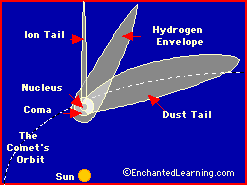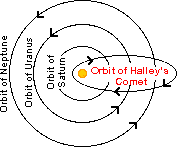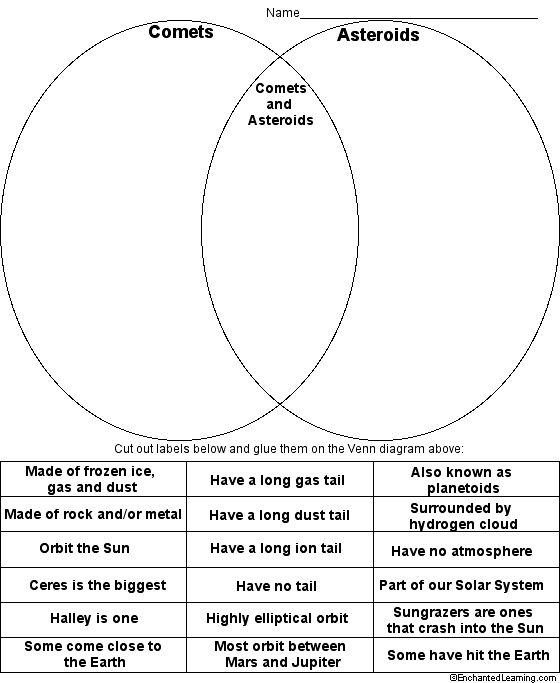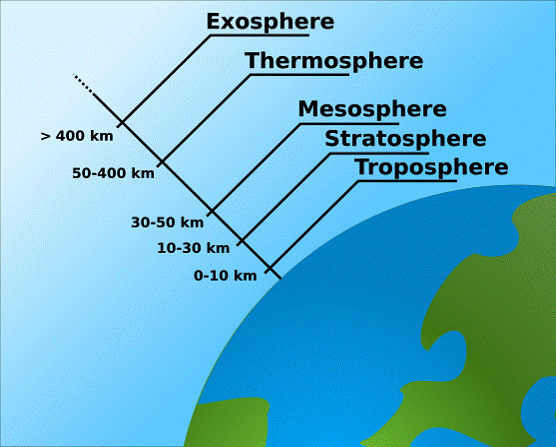Файл: Учебное пособие Астрономия. Космическая техника и технологии Алматы, 2012 удк 802. 0 52 629. 7 (0758) ббк 81. Англ. 923.docx
ВУЗ: Не указан
Категория: Не указан
Дисциплина: Не указана
Добавлен: 16.03.2024
Просмотров: 99
Скачиваний: 0
ВНИМАНИЕ! Если данный файл нарушает Ваши авторские права, то обязательно сообщите нам.
10) Is the number of known asteroids over 0.5 miles (about 1 km) in diameter closest to: 40; 400; 4,000; 40,000 or 400,000?
Asteroid:
Cloze Activity
Fill in the blanks below
Word Bank:
| planetoids years Sun gaps gravitational | Mars moons km orbit Kirkwood | belt asteroid Moon coalesced atmospheres |
Asteroids are rocky or metallic objects, most of which orbit the ___ in the asteroid belt between the planets ___and Jupiter. A few asteroids approach the Sun more closely. Asteroids are also known as ___ or minor planets. The first ___discovered (and the biggest) is named Ceres; it was discovered in 1801.
About 3,000 asteroids have been cataloged. Asteroids range in size from tiny pebbles to about 578 miles (930 kilometers) in diameter (Ceres). There are about 40,000 known asteroids that are over about 0.5 miles (1 ___) in diameter in the asteroid belt. Sixteen of the 3,000 known asteroids are over 150 miles (240 km) in diameter. There are many smaller asteroids. Some large asteroids even have orbiting ___. None of the asteroids have ___.
The asteroid ___ is a doughnut-shaped concentration of asteroids that orbit the Sun between the orbits of Mars and Jupiter, closer to the orbit of Mars. Most asteroids orbit from between 186 million to 370 million miles (300 million to 600 million km or 2 to 4 AU) from the Sun. The asteroids in the asteroid belt have a slightly elliptical ___. The time for one revolution around the Sun varies from about three to six Earth ___. The strong ___ force of the planet Jupiter shepherds (guides) the asteroid belt, pulling the asteroids away from the Sun, keeping them from falling into the inner planets.
The asteroid belt is not smooth; there are concentric ___ in it (known as Kirkwood gaps). These gaps are orbits where the gravitational forces from Jupiter do not let asteroids orbit (if there were asteroids there, they would be pulled towards Jupiter). The ___ gaps are named for Daniel Kirkwood who discovered them in 1866.
The asteroid belt may be material that never ___ into a planet, perhaps because it’s mass was too small; the total mass of all the asteroids is only a small fraction of that of the Earth's ___. A less satisfactory explanation of the origin of the asteroid belt is that it may have once been a planet that was fragmented by a collision with a huge comet.
Text 6B
Comets
A comet is a small, icy celestial body that orbits around the sun. It is made up of a nucleus (solid, frozen ice, gas and dust), a gaseous coma (water vapor, CO2, and other gases) and a long tail (made of dust and ionized gases). The tail develops when the comet is near the Sun. Its long ion tail always points away from the sun, because of the force of the solar wind. The tail can be up to 250 million km long, and is most of what we see. Comets are only visible when they're near the sun in their highly eccentric orbits.


Parts of Comet
Nucleus: The nucleus is the frozen center of a comet's head. It is composed of ice, gas, and dust. The nucleus contains most of the comet's mass but is very small (about 1 to 10 km across - or more).
Coma: The coma is the roughly spherical blob of gas that surrounds the nucleus of a comet; it is about a million km across. The coma is comprised of water vapor, carbon dioxide gas, ammonia, dust, and neutral gases that have sublimed from the solid nucleus. The coma and the nucleus form the head of a comet.
Ion Tail: A tail of charged gases (ions) always faces away from the sun because the solar wind (ions streaming from the sun at high velocities) pushes it away (it is also called the plasma tail). When the comet is approaching the Sun, the ion tail trails the comet: when the comet is leaving of the Sun, the ion tail leads. The tail fades as the comet moves far from the Sun. The ion tail can be well over 100 million km long
Dust Tail: The dust tail is a long, wide tail composed of microscopic dust particles that are buffeted by photons emitted from the Sun; this tail curves slightly due to the comet's motion. The tail fades as the comet moves far from the Sun.
Hydrogen Envelope: Hydrogen gas surrounds the coma of the comet and trails along for millions of miles (it is usually between the ion tail and the dust tail). The hydrogen envelope is about 10 million km across at the nucleus of the comet and about 100 million km long. It is bigger when the comet is near the Sun.
A comet’s orbit: comets orbit the Sun in highly elliptical orbits. Their velocity increases greatly when they are near the Sun and slows down at the far reaches of the orbit. Since the comet is light only when it is near the Sun (and is it vaporizing), comets are dark (virtually invisible) throughout most of their orbit. The solar wind pushes the tail away from the Sun. Some comets crash into the Sun or get so close that they burn up; these comets are called sun grazers.
Comet exploration: NASA's Stardust Mission will visit the Comet Wild 2 in 2004. It will take a sample of comet particles and return them to Earth. The small spacecraft (about 770 pounds = 350 kg) was launched February 7, 1999 and rendezvoused with comet Wild 2 in January, 2004. It will return to Earth on January 15, 2006, and land in western Utah, USA. Comet Wild 2 (aka Comet 81P) is a short-period comet that was discovered by the Swiss astronomer Paul Wild on January 6, 1978. The comet's nucleus is about 3 miles (5 km) across. Wild 2 orbits the Sun every 6.39 years; its elliptical orbit ranges from about Mars' orbit to Jupiter's orbit.
Cosmic snowballs: there is a new and very controversial theory that comets (composed of frozen water) are constantly bombarding the Earth. These "cosmic snowballs" have (perhaps) been seen by the visible imaging system of the Polar Satellite. In theory, these frozen comets vaporize in the atmosphere, adding water vapor to the environment.
Label the Comet
Label the comet diagram using the terms below.

coma - The roughly spherical blob of gas that surrounds the nucleus of a comet; it is about a million km across. The coma is comprised of water vapor, carbon dioxide gas, and other neutral gases that have sublimed (evaporated from a solid, skipping the liquid phase) from the solid nucleus.
dust tail - A long, wide tail buffeted by photons emitted from the Sun, but it curves slightly due to the comet's motion.
hydrogen envelope - Hydrogen gas that surrounds the coma of the comet and trails along for millions of miles (it is usually between the ion tail and the dust tail). The hydrogen envelope is about 10 million km across at the nucleus of the comet and about 100 million km long.
ion tail - A tail of charged gas particles (ions) that always faces away from the sun because the solar wind (composed of ions streaming from the sun at high velocities) pushes it away.
nucleus - The frozen center of the comet's head. It is made of ice, gas, and dust. It contains most of the comet's mass but is very small (about 1 to 10 km across).
Answer the questions:
1) What celestial body do comets orbit?
2) What is the nucleus of a comet made of?
3) Is a comet's coma solid, liquid, or gaseous?
4) When is the tail of a comet visible?
5) Are comets in circular or elliptical orbits?
6) Name a well-known comet whose visit was recorded in ancient times.
7) What is the name for the process in which a solid matter (like a comet's nucleus) goes directly to a gaseous state?
8) Does a comet's tail ever face the Sun?
9) What happens when the Earth crosses a comet's orbit and encounters comet debris?
10) What is the name of a comet that crashes into the sun (or gets so close that it burns up)?
Comets
Cloze Activity
Fill in the blanks below
Word Bank:
| Halley's km burn solar wind orbits | nucleus Sun slows Earth sun grazers | atmosphere elliptical vaporizing tail gases |
A comet is a small, icy celestial body that ___ the Sun. Comets are made up of a ___ (it is solid ice, gas and dust), a gaseous coma that surrounds the nucleus (it is made of water vapor, CO2, and other ___) and a long ___ (made of dust and ionized gases). The long tail of gas and dust always points away from the ___, because of the force of the ___ (a continuous stream of electrically charged particles - ions- that are given off by the Sun). A comet's tail can be up to 250 million ___ long, and is most of what we see of the comet. Some well-known comets are ___, Shoemaker-Levy 9, Hale Bopp, and Swift-Tuttle.
Comets orbit the Sun in highly ___ orbits. Their velocity increases greatly when they are near the Sun and ___ down at the far reaches of the orbit. Comets are light only when they are near the Sun (when the gas is ___); comets are dark (virtually invisible) throughout most of their orbit. We can only see comets when they're near the Sun. Some comets crash into the Sun or get so close that they ___ up; these comets are called ___.
The ___passes through the orbit of some comets. When this happens, the left-over comet debris (rocks, etc.) bombards the Earth, and the debris burns up in our ___. This is called a meteor shower; in it, many meteors fall through the atmosphere in a relatively short time.
Listening
What powers a comet?
Welcome to Space Place Musings with Diane Fisher of the New Millennium Program! We are going to listen to a Podcast in which an expert answers questions from our Space Place museum and astronomy club partners across the nation. Our expert is Dr. Marc Rayman, a scientist at the Jet Propulsion Laboratory. For questions 1-8 complete the sentence:
1) Comets travel very fast, loop around the Sun, and have long ___.
2) About 4.6 billion years ago, our solar system formed from a vast cloud of gas and dust. More than 99% of the material in the cloud collected at the center and formed the Sun. Other big clumps of gas and dust became the planets, including Earth. Some of the material that didn't get caught up in the Sun or planets gathered into smaller chunks, sometimes just a few kilometers across. Many of these chunks are what we call ___.
3) Because the comets are much lighter and smaller than planets, they are easily pulled this way and that by the gravity of the planets (or, in some cases, even by stars). So when we see them streaking through the solar system, they often aren't following the kind of neat, nearly circular orbits that most ___ do.
4) The solid part of the comet, its “nucleus,” is like an icy dirtball with pockets of air trapped inside. When a comet’s orbit brings it into the inner solar system, some of the ice and gas are heated by the Sun, and they expand to form a cloud around the nucleus. Although the nucleus may be only a few kilometers across, the cloud, called a ___, can be thousands of kilometers across—even larger than Earth.
5) Light and other radiation from the Sun push on the gas and dust in the coma, blowing the material away to form a tail that can be millions of kilometers long. So the tail always points away from the Sun, regardless of whether the comet is traveling toward ___ or away.
6) Sun provides the heat that drives some of the material from the nucleus into the huge coma, and it provides the pressure to push some of that into the long and beautiful ___.
7) Well, comets formed in the rotating cloud that produced the solar system, so that rotation got them started on their orbits of the Sun. This is the same reason Earth and the other planets orbit the Sun. But still another force acts on comets. When gases inside the nucleus expand under the heat of the Sun, they often shoot through holes or weak spots in the crust of the nucleus, like the steam coming from the hole in a tea pot. The expanding gas and dust escape in jets, having the same effect as thrusters on a ___, changing the comet's path, and, by the way, making its orbit hard for astronomers to predict precisely.
8) I was lucky enough to be in charge of Deep Space 1 when it flew through the coma of Comet Borrelly in September 2001. The spacecraft had already accomplished its primary mission, so this was a bonus, risky maneuver. We had to design and upload some special software modifications for our advanced autonomous navigation system, which used the spacecraft’s high-tech camera. We made the spacecraft on its own find the comet’s nucleus deep within the coma and take ___ of it.
Complete the diagram:
| Comets and Asteroids Venn Diagram | |

Activity
Work in pairs and speak about similarities and differences between comets and asteroids.
Quiz: Space and the Universe
1) What are chunks of rocks of varied size in space called?
a) comets
b) shooting stars
c) stars
d) asteroids
2) What 2 planets are most of the asteroids in our solar system found between?
a) Mars and Jupiter
b) Mercury and Venus
c) Earth and Mars
d) Saturn and Jupiter
3) A star is a spinning ball of hot luminous gas which releases what through nuclear reactions?
a) gravity
b) sound
c) energy
d) dust
4) All of the planets have at least one moon, except for which two?
a) Venus and Mercury
b) Saturn and Mars
c) Jupiter and Venus
d) Pluto and Neptune
5) The elements hydrogen and helium together comprise what percent of almost all matter in the Universe?
a) 75 percent
b) 83 percent
c) 96 percent
d) 98 percent
6) What is the constellation Orion?
a) hunter
b) dove
c) winged horse
d) swan
7) Approximately how many miles away is the moon from earth?
a) 96,077 miles
b) 238,866 miles
c) 338,660 miles
d) 1,833,900 miles
8) Which of these four is usually farthest from the sun?
a) Jupiter
b) Uranus
c) Saturn
d) Pluto
9) Which planet is the largest in size?
a) Earth
b) Neptune
c) Jupiter
d) Saturn
10) Who discovered Pluto in 1930?
a) Joahann Encke
b) Edwin Hubble
c) Herbert R. Pluto
d) Clyde Tombaugh
Unit 7
The atmosphere
Text 7A
The atmosphere
The earth is surrounded by layers of gases, our atmosphere. They are kept near the earth’s surface by gravity. Our atmosphere filters the sunlight and keeps dangerous rays from reaching our planet. Without such a filter it would get too hot during the daytime. At night it prevents heat from escaping so it does not get too cold. Without an atmosphere life on our planet would not be possible. It also makes our world a more
pleasant place to live. Air carries sound waves, which let us hear voices or listen to music. The atmosphere creates rainbows, makes the sky turn blue on clear days and the sun red when it sets.
The air near the earth’s surface consists of 77 percent nitrogen and about 21 percent oxygen. Carbon dioxide is also present, but only in small amounts. Nevertheless it is very important because green plants use it when they make their food. Higher up you can find helium and hydrogen in the atmosphere. Not all gases are created by nature, some are produced by people. Methane rises into the atmosphere from decaying plants and animals. Carbon monoxide and chlorofluorocarbons (CFCs) enter the atmosphere because of industrial activities.
We often think that the air is weightless but it isn’t. The whole weight of the earth’s atmosphere is about 5.5 quadrillion tons (55 followed by 14 zeros). Air is heaviest at sea level because the air molecules are pressed together. It also presses against our bodies but we have pressure inside, so we don’t feel it. When you move farther away from the earth’s surface the atmosphere gets lighter and lighter because there is more room between air molecules. The weight of the air decreases and so does air pressure.
Layers of the atmosphere

Troposphere
The troposphere is the layer closest to the earth’s surface and the part of the atmosphere that we know about best. It extends from sea level to almost 19 km above the equator, but only 9 km above the North and South Poles. In the troposphere it gets colder the higher up you move. Temperatures drop by about 0.7°C to 1 ° C every 100 meters.
This lower part of the atmosphere is responsible for our weather. Water evaporates from oceans and rivers and forms clouds which can produce, rain or snow. Winds also get stronger the higher you go up. At the top of the troposphere so-called jet streams reach speeds of up to 300 km an hour.
As you go up the air gets thinner. People must wear pressure suits and use oxygen masks when they travel to higher regions. The troposphere helps to keep the temperatures on earth moderate.
Stratosphere
The second layer of our atmosphere is the stratosphere. It extends up to an altitude of 50 km above the earth’s surface. A gas called ozone causes the temperature to rise again. Ozone absorbs the ultraviolet light that comes from the sun and changes it into heat. Without ozone this dangerous light would reach the earth’s surface, cause skin problems and harm plants and animals.
Mesosphere
The mesosphere extends from the top of the stratosphere to about 80 km. The air becomes even thinner and the temperatures drop again. At the top of the mesosphere they may be lower than - 75° C.
Thermosphere
The thermosphere ranges from 80 km to about 400 km above the earth. In this layer temperatures increase rapidly with altitude. At the bottom temperatures are below freezing, at the top they can reach over 1,000 °C. Satellites orbit the earth at this height.
Exosphere
In the outermost layer of the atmosphere temperatures are steady, averaging around 1200°C. Molecules in the exosphere are so far away from each other that they normally don’t collide. The layer extends into outer space and joins with the atmosphere of the sun and other planets. Atoms and particles escape the earth’s gravitation and float to outer space.
Endangered Atmosphere
During millions of years the atmosphere has remained the same. It can change when, for example, when ashes and hot gases
